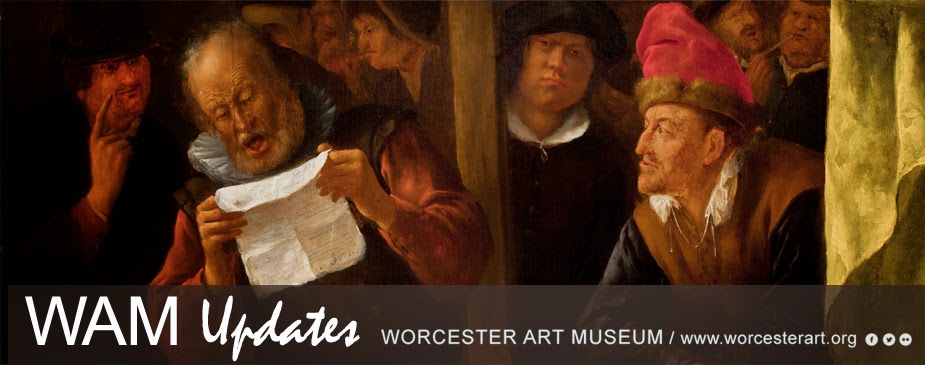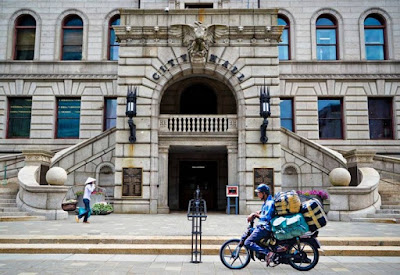Every year nearly 20,000 visitors—including hundreds of Worcester Public School students—experience the Worcester Art Museum on a docent-led tour. Next week, we launch our celebration of the 50th anniversary of the docent program, the cornerstone of the Museum’s education program and vital to its mission of connecting people, communities, and cultures through the experience of art.
“These devoted volunteers are great lovers of art, whose commitment to sharing that passion comes through with every Museum conversation,” says Aileen Novick, manager of public and education programs, which includes the docents. |
| Docent Cathryn Oles leads a tour with students from Worcester's Jacob Hiatt Magnet School in 2016. |
Women who “expressed an interest in art and an affection for WAM” were invited to participate in a 30-week training program, which began on September 28, 1970. Classes were conducted in the galleries and designed to give the volunteer guides a working knowledge of the Museum’s permanent collection.
The 82 female participants enthusiastically embraced and rose to the challenge. The first docent-led tours of the Museum were offered to college instructors and public-school principals in September 1971. By April 1972, 51 docents had conducted 445 tours.
 |
| Some of the Museum’s early docents are pictured here. |
The program continued to adapt to the needs of the Museum and community. In the 1980s, trainees were especially encouraged to develop participatory activities for children. In 1981, the Docent-in-the- Schools (DIS) program provided a three-lesson experience with a specific theme for children from the Worcester Public Schools. Docents went to schools before and after they visited the Museum.
Otti Levine, a 31-year WAM docent, participated in the DIS program at Elm Park Community School. “This was a great program for the children. They were always excited to come to the Museum,” she recalls. “There was a special bond formed with the docent and the students because of these visits.”
A college student recognized Otti from the DIS program years later. “She told me she was getting a degree in art!” she recalls. This feedback inspires Otti’s role as a docent. “Because of the interaction with people, I can really make them see, engage, and appreciate art,” she explains.
In 1987 additional coursework was added to introduce the docents-in-training to the critical-thinking skills necessary to integrate information with the experience of looking at works of art. And by the 1990s—and continuing through today—docents became even more proficient in introducing art and the Museum’s collection and exhibitions to visitors of all ages.
 |
| Ginny Powell-Brasier engages with a captivated audience of school children on her docent tour. |
Leslie eventually joined a class and has been a docent for 11 years. “My mother’s health began to decline around that time, and I would bring her to the Museum and attend classes with her. We even did a few tours together,” Leslie said. Jean continued as a WAM docent until her death in 2017.
“My mother was right,” she adds, “I love being a docent! I am a retired teacher and that really helps with tours. I am most comfortable with children.”
In 1994 men joined the ranks of WAM docents. Paul Mahon, a former science professor and longtime collector of Asian art, became a docent when he retired from academia in 2007. He relished the opportunity “to teach about magnificent art while standing in front of it, and no grading, to boot!” Becoming a docent allowed Paul to incorporate knowledge he acquired while visiting hundreds of museums in Europe and Asia.
“I enjoy sharing my love of art with visitors of all ages, from cub scouts to seniors,” he says. “I also love training fellow docents in STEAM tours where my science background is especially helpful.”
 |
| Paul Mahon, a former science professor and longtime collector of Asian art, became a docent when he retired from academia in 2007. |
Jan Ewick, tour programs supervisor, has worked with WAM docents for nearly three decades. “These dedicated volunteers share their passion for art, the Museum, and discovery with visitors of all ages each year,” she said. “Their contributions of time and knowledge are immeasurable and, in keeping with the Museum’s mission of connecting people, communities, and cultures through the experience of art, our docents truly walk the walk.”
These sentiments are echoed by Director of Education and Experience Marnie Weir, "We couldn’t do what we do without our docents. They are an incredible group, whose engagement and enthusiasm tell such a special story.”
—By Cynthia Allegrezza, Marketing coordinator
September 24, 2020























